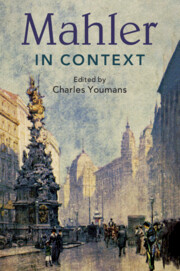Book contents
- Mahler in Context
- Composers in Context
- Mahler in Context
- Copyright page
- Dedication
- Contents
- Figures
- Music Examples
- Notes on Contributors
- Preface and Acknowledgments
- Abbreviations
- Part I Formation
- Part II Performance
- Part III Creation
- Part IV Mind, Body, Spirit
- Part V Influence
- Chapter 27 Posthumous Reputation, 1911 to World War II
- Chapter 28 Mahler and the Second Viennese School
- Chapter 29 The Mahler Revival
- Chapter 30 Broader Musical Influence
- Chapter 31 Adorno
- Chapter 32 Influences in Literature
- Chapter 33 Mahler on Disc
- Chapter 34 Film and Recent Popular Culture
- Further Reading
- Index
Chapter 27 - Posthumous Reputation, 1911 to World War II
from Part V - Influence
Published online by Cambridge University Press: 18 December 2020
- Mahler in Context
- Composers in Context
- Mahler in Context
- Copyright page
- Dedication
- Contents
- Figures
- Music Examples
- Notes on Contributors
- Preface and Acknowledgments
- Abbreviations
- Part I Formation
- Part II Performance
- Part III Creation
- Part IV Mind, Body, Spirit
- Part V Influence
- Chapter 27 Posthumous Reputation, 1911 to World War II
- Chapter 28 Mahler and the Second Viennese School
- Chapter 29 The Mahler Revival
- Chapter 30 Broader Musical Influence
- Chapter 31 Adorno
- Chapter 32 Influences in Literature
- Chapter 33 Mahler on Disc
- Chapter 34 Film and Recent Popular Culture
- Further Reading
- Index
Summary
In the years from his death to the outbreak of the Second World War, Mahler’s music was in various degrees admired, misunderstood, celebrated, condemned, and ignored. The range of musical figures who engaged with it spans the continent geographically and aesthetically: the Viennese creative, critical, and academic intelligentsia; Europe’s leading conductors (Oskar Fried, Willem Mengelberg, Bruno Walter, Otto Klemperer, Hermann Scherchen, and Wilhelm Furtwängler); younger, forward-thinking Germans (Kurt Weill); adventurous British musicians and writers (Benjamin Britten, Henry Wood, Hamilton Hardy, Donald Francis Tovey, T. E. Clark); curious French pedagogues (Nadia Boulanger); central personalities in US music (Aaron Copland, Leopold Stokowski, Serge Koussevitzy, Olin Downes, Deems Taylor); and Russians eager to remain connected (Ivan Sollertinsky, Dmitri Shostakovich). The varied interests and opinions embodied in this group are surveyed here with a view to laying out the lively breadth with which this music was discussed in a supposedly quiet time of the composer’s reception history.
Keywords
- Type
- Chapter
- Information
- Mahler in Context , pp. 235 - 241Publisher: Cambridge University PressPrint publication year: 2020

